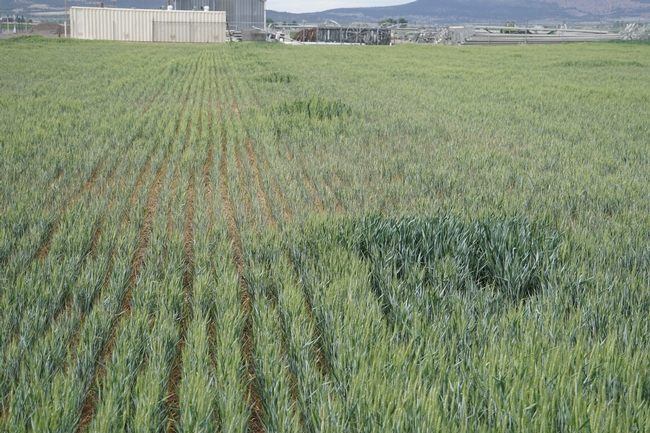It has been heart breaking to seeing wheat and alfalfa fields dry up the last few weeks. The recent hot temperatures caused many fields to wither, while placing greater irrigation needs on the few crops being irrigated with well water. It's the driest year I have experienced in my 10 years in the Klamath Basin!
Several people asked me about strategies moving forward this summer and what yields they can expect from crops with limited irrigation. I do not know all the answers, but I tried to highlight some of my past experiences from research and farming below. Please keep in mind every field situation is unique and one strategy rarely works in all situations. I want to commend the farming community for being resilient in a terrible situation. I also want to thank all those that have spent countless hours trying to improve the water situation today and in the future.
Irrigation tips
Almost all fields started this year with very little residual soil moisture. At IREC, not a drop of water flowed through our tile drains this winter and spring. Darrin and I noticed the first irrigation on many fields did not even refill the soil profile especially when irrigating during strong winds. This made 2021 even more difficult as winter precipitation did not refill the soil profile naturally. As a result, many alfalfa and grain fields are starting to show unusual patterns from drought such as wind strips and tall growth under sprinkler drains. If you can water fields with well water, it is very important to check the sprinkler heads to make sure they are the proper size, check water pressure on the ends of irrigation lines, and make sure your irrigation is providing good coverage. Offset your wheel-lines one roll the next irrigation in fields with wind strips. As many of us are irrigating out of drains, it is important to make sure you have adequate sprinkler pressure. If you do not have adequate pressure, you need to reduce the size of your sprinkler heads and extend the duration of the irrigation set (16 hrs vs 12 hrs) or run less lines.
Many alfalfa producers are in the position to harvest 1st cutting and cannot water for the next couple weeks until the hay is picked up. In this situation, producers should consolidate limited water on their most productive fields. Once an alfalfa field wilts from drought it will typically go dormant. This is good as the alfalfa will likely survive until next year, but it also means the alfalfa is resistant to green-up and grow again in mid-summer. As such, I'd recommend using limited water to irrigate healthy fields instead of trying to stretch it across all fields especially those fields that are already wilted with poor growth going into first cutting.
Potato producers will need to apply long sets to refill the soil profile when the potatoes emerge. Most field have very little residual soil moisture, and it is important to avoid drought stress during vegetation growth and tuber initiation to maximize tuber set and tuber quality. I advise potato growers to check soil moisture frequently throughout the potato rooting zone to make sure water reached the bottom of the hill and is uniform throughout the field.
Most farmers should be done irrigating winter grain, and I see a few producers irrigating spring grain. If you decide to irrigate spring grain, I recommend irrigating the crop fully until you run out of your water allocation instead of trying to space irrigation throughout the summer. Irrigating spring grain fully to meet the crop water demand during tillering and elongation will maximize forage yields, and once wheat and barley fields show signs of drought stress, they will start to head producing low forage and grain yields.
Fertilization tips
Producers that decide to irrigate grain and grass fields should make sure to apply adequate nitrogen. The cost of the fertilizer will easily pay for itself with high forage prices and nitrogen can double grass forage yields compared to leaving fields unfertilized. Granular nitrogen fertilizer applied as a topdress (over the top of the crop) should be watered into the soil with at least an inch of water within a few days of application to prevent volatility losses. Don't fertilize fields if you do not have adequate water to irrigate crop!
Pest Management tips
2021 is shaping up to be a very bad pest year. We have already witnessed problems with blue aphid and weevils in alfalfa, and I am starting to see armyworms in grain and alfalfa. We had a very high population of seedcorn maggot in onions as all the maggot flies seemed to congregate in the few irrigated fields throughout the basin. Thrip populations are also very high. Onion producers should start scouting for thrips earlier than normal and be ready to start insecticide applications if thrip numbers build on young plants. Potato producers should expect higher than normal pest populations. Aphid populations are high, and many insects will be moving into potato fields after alfalfa and grain harvest. Mites may be more problematic than normal as fields are receiving less overhead irrigation and we have a lot of dust in the air. I hope the dry weather will help reduce foliar crop diseases, but the hot temperatures and stagnant water sources may make my prediction incorrect. Potato and onion farmers need to apply frequent irrigation to keep up with crop water use, so make sure to scout for foliar diseases and try to avoid keeping leaf surfaces wet for extended periods.
